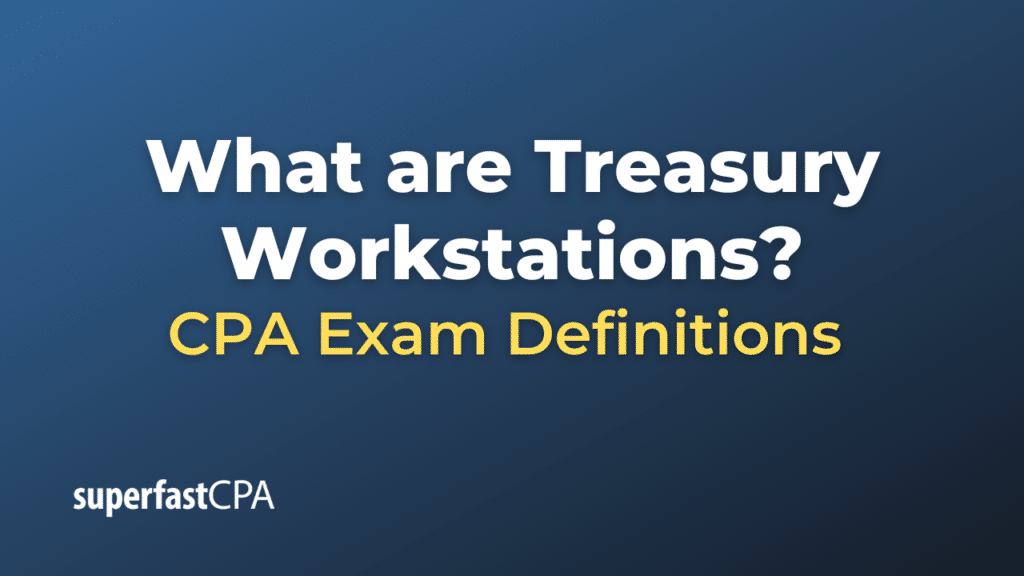Treasury Workstations
A Treasury Workstation, often referred to as a Treasury Management System (TMS), is a software application or system designed to automate and streamline the operations and processes of a corporate treasury department. These systems help treasurers manage cash flow, liquidity, financial risks, and provide robust reporting capabilities.
Key functionalities and benefits of a Treasury Workstation include:
- Cash Management: Provides a consolidated view of an organization’s cash position, helping treasurers manage daily cash flows and optimize cash reserves.
- Liquidity Management: Allows for effective management of liquid assets to ensure that the organization can meet its short-term financial obligations.
- Debt and Investment Management: Assists in tracking and managing the company’s debt portfolio, including loans, bonds, and other credit facilities, as well as managing investments.
- Risk Management: Provides tools to manage various financial risks such as interest rate risk, foreign exchange risk, and commodity price risk. This includes features like derivative accounting and valuation.
- Electronic Banking: Enables secure and efficient electronic bank transactions, bank communication, and bank statement reconciliations.
- Forecasting and Budgeting: Assists in predicting future cash flows and liquidity needs based on historical data and predictive models.
- Reporting and Analytics: Offers comprehensive reporting tools, dashboards, and analytics for a detailed analysis of the company’s financial position and performance.
- Integration Capabilities: Most TMS solutions can integrate with other systems like Enterprise Resource Planning (ERP) systems, Customer Relationship Management (CRM) systems, and banking platforms to ensure real-time data flow and accuracy.
- Compliance and Control: Aids organizations in adhering to financial and accounting regulations. Also, it provides robust access controls to ensure that only authorized individuals can perform certain operations.
Example of Treasury Workstations
Let’s delve into a more concrete, fictional example to illustrate how a Treasury Workstation (TMS) might be beneficial for a company.
Scenario:
Imagine a multinational company named “OceanLink Enterprises,” which manufactures and sells marine equipment. OceanLink operates in over 20 countries, deals with multiple currencies, and has numerous bank accounts across the globe.
Challenges Faced by OceanLink:
- Multiple Bank Accounts: OceanLink’s treasury team finds it challenging to track real-time cash balances across their 50+ bank accounts worldwide.
- Foreign Exchange (FX) Risk: With revenues and expenses in various currencies, the company is exposed to significant foreign exchange risks.
- Complex Liquidity Management: Managing liquidity is complicated due to diverse operations, with varying cash flow timings and magnitudes.
- Manual Reporting: Monthly treasury reporting is a tedious, manual process, often prone to errors.
- Inefficiencies in Payment Processes: Paying suppliers and receiving payments from customers across different countries involves various payment systems, leading to inefficiencies.
Implementation of a Treasury Workstation:
OceanLink decides to invest in a TMS to streamline its treasury functions. Here’s how it helps:
- Consolidated Cash View: The TMS provides a dashboard where the treasury team can view consolidated and individual cash balances across all bank accounts in real-time.
- Automated FX Management : The system monitors FX exposures in real-time and can automate or suggest hedging strategies to minimize risks. For example, if the company has a significant receivable in euros but most expenses in US dollars, the system might suggest purchasing a forward contract to hedge against euro depreciation.
- Efficient Liquidity Management : The TMS offers tools that allow OceanLink to optimize cash reserves, ensuring that excess cash is invested, and deficits are funded efficiently.
- Automated Reporting: The system can automatically generate detailed treasury reports at any required frequency, reducing manual effort and errors.
- Centralized Payment Processing: The TMS centralizes payment processes, making it more efficient to handle payments and receipts across different countries and systems.
Outcome:
After the implementation of the Treasury Workstation:
- OceanLink’s treasury department is now more efficient and proactive in managing the company’s finances.
- The company can react quickly to any financial risks, thanks to real-time data and analytics.
- Operational costs related to treasury functions have decreased due to automation and reduced manual interventions.
- The CFO receives timely and accurate reports, aiding in strategic decision-making.
This example showcases how a TMS can significantly transform and optimize the treasury functions of a multinational company.













